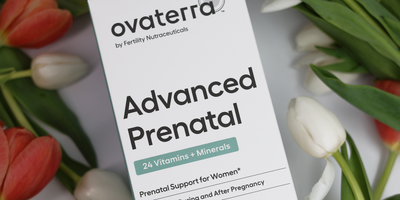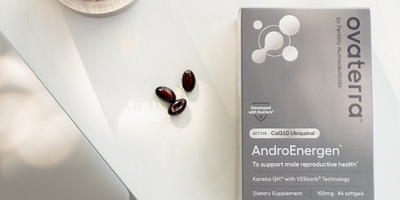Implantation is the next step after fertilization in the reproductive process. Once an ovulated egg meets sperm in the fallopian tube and gets fertilized, the fertilized egg (now called an embryo) travels down the fallopian tube, enters the uterus and attaches itself to the wall of the uterus. Typically, implantation happens somewhere between 6 and 12 days from ovulation.
Even in our peak fertility years, humans have a just ~30% chance of pregnancy each cycle, where the embryo implants safely and its heartbeat becomes detectable. Based on multiple evidence, scientists hypothesize that about 30% of the embryos do not implant at all, and another 30% are lost soon after implantation, usually without ever being detected. (The ratios vary, depending on the study.) But what’s involved in this process? What affects implantation? Let’s look at 3 factors.
How do embryos implant in the uterus?
Implantation is a complex process. Some doctors and scientists call implantation a “black box,” because there’s a lot we still don’t know about this crucial step in a pregnancy. However, we know that at least 3 inter-connected factors are involved: The embryo itself, the uterus and its lining (endometrium), and the hormonal and immunological environment.
Emerging research suggests that an implanting embryo and the cells in the endometrial lining communicate with each other. This chemical communication triggers some important changes in the uterine environment: The structure and functions of the endometrium changes in a process called decidualization to allow the embryo to take up residence in the uterus and start growing.
Implantation is a multi-step process. After ovulation and fertilization, the embryo enters the uterus but keeps floating free for a few days. The embryo then loosely grabs onto the surface of the endometrium. At this stage, the bond is surface-level and unstable, but gradually becomes more stable. Then, the embryo hatches out of its outer layer (called zona pellucida) and “invades” deeper into the uterine tissue.
At this point, implantation is more or less complete, but the placenta – which would supply oxygen and nutrients to the growing baby – isn’t there yet. It’ll take about 8-12 weeks into the pregnancy to fully form. So, the embryo receives all the nutrients it needs from the glands in the endometrium in these early weeks of pregnancy.
What affects an embryo’s chance of implantation?
All 3 factors – the embryo, the endometrium and the environment – have an impact on the success of implantation. Let's take a look at each one.
1. Embryo quality
The health of the embryo itself affects the likelihood of implantation. A surprisingly high percentage of human embryos carry chromosomal abnormalities. Also called aneuploidy, chromosomal abnormalities are the abnormalities in the number and composition of the chromosomes that carry the DNA.
Patly depending on the age of the mother, the rate of chromosomal abnormalities can be anywhere between 10% and over 50%. Some studies suggest that human aneuploidy rate can be much higher. For example, a 2017 study of women under 37 found that a whopping 63% of embryos carried chromosomal abnormalities.
Many chromosomal abnormalities are lethal, and embryos with these abnormalities usually don’t implant or are miscarried very early, often unbeknownst to the women. This is not to be alarmist - it's the nature's way of ensuring healthy pregnancy and healthy babies.
This high rate of aneuploidy is partly why even young, healthy couples at their peak fertility don’t conceive right away. On average, couples in their early to mid-20s take 3-4 months to get pregnant. It typically takes longer for women in their 30s and 40s.
2. The uterus and endometrial receptivity
While much of the scientific attention has been focused on the embryo, some emerging evidence suggests that the readiness of the endometrium may be just as important as embryo quality for successful implantation. We know, for example, that an adequate thickness of the endometrial lining of at least 7-8 mm significantly increases the chance of pregnancy. Even a perfectly normal, healthy embryo may not implant when the endometrium is not thick enough.
The thickness of the endometrium is not the only factor involved. Scientists use the term “endometrial receptivity” to capture all the conditions that facilitate implantation. The endometrium is receptive to implantation for just 3-6 days for most women. In order to embed itself in the uterus and start growing, an embryo has to arrive in the uterus within this implantation window.
Interestingly, embryos can implant even in tissues where they can’t develop further – for example, in the fallopian tube, when it becomes an ectopic pregnancy. Endometrium, on the other hand, has an ability to prevent embryos from implanting when the conditions aren’t right.
Another uterine aspect of implantation is the health of the uterus itself. It needs to be anatomically normal and free of conditions that can interfere with implantation. These conditions can impact implantation through changes in the physical shape of the uterus, its hormonal environment or the level of inflammation.
3. Hormonal and immunological environment
Implantation requires well-timed changes in the hormonal and immunological functions – locally in the uterus, as well as on the systemic level.
Hormonal changes during implantation
Changes in the balance of reproductive hormones facilitate implantation and support the early pregnancy. Progesterone is at the top of the list. Implantation typically coincides with peak progesterone levels, and according to a study of 189 pregnancies, later implantations that didn’t coincide with peak progesterone were less likely to proceed past 6 weeks of pregnancy.
How does progesterone encourage implantation? The rise in progesterone in the days following ovulation thickens the endometrium, ready for implantation. Then, through its action via the progesterone receptors, progesterone regulates many types of proteins that facilitate implantation at precise moments.
There are likely more proteins and molecules involved that we don’t know yet.
This is why women whose progesterone levels remain elevated past their implantation window are 5 times more likely to have a live birth than women whose progesterone levels drop. One of the next-generation ovulation trackers our scientific team recommends, Proov Predict & Confirm Kit, uses a patented method to measure and analyze the level of progesterone byproduct in your urine to assess the quality of your implantation window.

Another key hormone for implantation is hCG, human chorionic gonadotropin. You are probably familiar with hCG as the hormone that pregnancy tests use to detect an early pregnancy. While hCG levels increases as the pregnancy progresses, the very early, small rise in the hCG levels during implantation notifies the mom’s body that there is an ongoing pregnancy, and menstruation should be off the table. hCG also sustains the corpus luteum, so that it continues to secrete the all-important progesterone.
Immunological changes during implantation
At the same time, the mom’s immune system goes through a (pretty remarkable!) transformation to make it possible for the embryo to survive. Only 50% of the embryo’s genetic material is from the mom, with the other 50% coming from the dad. This genetic makeup actually makes the embryo a foreign invader, like a virus, in the eyes of the mom’s immune system.
Normally, the mom’s immune system would attack the invader to defend the body from harm. In a successful implantation, the mom’s immune system transforms itself so that it can tolerate the embryo. The immune system stays accommodating toward the growing baby throughout the pregnancy until delivery.
The downside? Your immunological defenses are lower during pregnancy. This is why women tend to get more infections and the symptoms tend to be worse.
Regulatory T cells in the endometrium, a type of T cell that suppresses immune response to maintain homeostasis and self-tolerance, play an important role in this establishment – and maintenance – of immunotolerance. Another factor is the previous exposures to the partner’s genetic material via his semen. Interestingly, research suggests that progesterone also helps this immunological transformation acting as an anti-inflammatory agent.
What else can impact implantation?
Reproductive processes are like a rocket ship: Everything has to work properly, together and at the precise moments for the project’s success. Implantation is the same. While there are still a lot of unknowns, scientists think systemic health plays an important role in implantation.
Some of these factors, like smoking and alcohol consumption, are within your control. You can also take action with your doctor’s help on others. Here are a handful of factors involved in implantation:
- Thyroid health: Thyroid hormones, T3 and T4, regulate the production of progesterone and other reproductive hormones. While the results are mixed, some studies have found that healthy thyroid functions are associated with better chances of implantation.
- Vitamin D status: A healthy level of Vitamin D has been associated with better chances of pregnancy. Scientists hypothesize that a part of the mechanism has to do with implantation, partly because endometrium has Vitamin D receptors and partly because of known impact of Vitamin D on placenta formation.
- Blood sugar levels: Normal glucose levels are important for pregnancy in general. Based on some animal studies, it’s also possible that healthy blood sugar levels may facilitate implantation by modulating the endometrial functions.
- Smoking: While light smoking may not affect the implantation process itself, the more you smoke, the more likely it negatively impacts implantation. There is also strong evidence that smoking in both men and women negatively impacts embryo quality, which is a factor in implantation.
- Weight: Obesity appears to have a negative impact on female reproductive health in many ways, including implantation. Some of the observed effects on implantation may be through its impact on egg quality, while others may be through alterations in gene expression, hormone balance and immune response.
- Alcohol: Excessive alcohol can increase cellular stress and trigger changes in the hormonal and nutrient signaling pathways. Some studies suggest that these effects of alcohol may reduce the chance of normal implantation.
- Endometrial microbiome: A very recent focus of research, the types of bacteria that colonize the endometrium have been suggested as potentially important for successful implantation. Scientists think that what bacterial species dominates your endometrium may have a significant impact on the endometrial cell function and how the local immune system works.
What affects implantation and what you can do
As we've seen, egg and embryo quality, uterine receptivity, and hormonal and immunological environment of the implantation window all impact your embryo's chance of implantation. To support implantation, focus on what you can control - while we can't turn back the clock to make our eggs (or sperm!) younger, there are some lifestyle factors within your control that can contribute positively to implantation.
To understand a key part of implantation, your progesterone levels throughout the implantation and beyond, consider using Proov Predict & Confirm Kit.
Talk to your doctor about what else you can do together to support implantation, and please reach out if we can answer any questions. We are with you.














